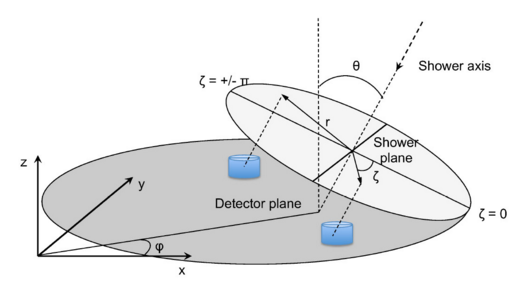In a recent publication, the Pierre Auger Observatory is looking at the tilt of the cosmic ray shower axis from the vertical that causes an asymmetry in the response of the tanks to look for the shower development history and in particular the mass of the primary cosmic rays.

Figure and Caption form Auger post: Schematic view of the shower geometry. The tilt of the shower axis from the vertical (the zenith angle theta θ) causes an asymmetry in the measured risetime around the shower plane. The detection of particles at different angles zeta (ζ), i.e. for any given water tank, can be earlier or further depending on the development of the cosmic-ray shower. The greater the inclination of the shower is from the vertical, the more pronounced the asymmetry becomes.
“We exploit this feature to extract an average estimated mass of the incoming cosmic rays as a function of energy, by comparing the asymmetry effect measured in the Auger water tanks with the results of complex particle simulations. We find a slow increase in the average cosmic-ray mass at primary energies from 4×1018 eV to 4×1019 eV, i.e., the cosmic rays are progressively more massive atomic nuclei. Such an indirect approach to assessing the primary cosmic-ray mass is necessary, since at the high energies of interest here the cosmic rays are very rare could not be directly observed with an instrument on a balloon or satellite: such are of a size that would require them to operate for thousands of years to observe even a single particle. And so indirect measurements of the cosmic rays are necessary through their air showers, with the advantage that thousands of detectors can be deployed over very large areas, as done with the Auger Observatory. The cosmic-ray mass assessment carried out here, albeit indirect and possible only on statistical samples of events and not for each cosmic ray individually, is nevertheless significant as it informs the possible origins of these extraordinarily energetic objects. For instance, distant active radio galaxies are postulated as their sources, but resolving the details of the physical acceleration and propagation of these rare particles will require accommodating this evidence of a growing nuclear mass at higher energies.” To read the full article on the Auger website, see here.

Interesting post about Pierre Auger Observatory. Thanks for sharing your thoughts with us. Have a Look: Chairs Hunt